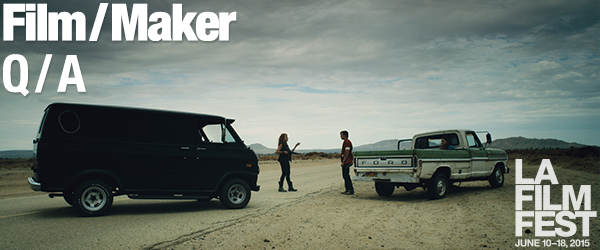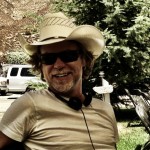How “Hillbilly Shakespeare” Produced Poetic Effect—The Story Behind What Lola Wants

Behind every (fill in the blank) great/glorious/funny/scary/sad story told on film is an equally great/glorious/funny/scary (yes, probably sometimes) sad story: the one about how the whole thing went from being an idea in a brain (probably many years ago) to a big screen premiere at a big-time Festival. In this Film/Maker Q/A blog series, our LA Film Fest programmers interview our LA Film Fest filmmakers to discover the stories behind the story.
Programmer Lucy Mukerjee-Brown chatted with director Rupert Glasson about the creative surprises that pop up while working with a low budget for his film What Lola Wants. The film follows 17-year-old Lola Franklin, untamed and irrepressible, who fools the world into believing she has been kidnapped when, in fact, she has run away to escape her Hollywood royalty parents. She convinces a charming thief named Marlo to teach her the art of pickpocketing, and soon they tear up the New Mexico countryside in this hyper-stylized ode to Bonnie and Clyde.
 The programming team found this film really provocative, and it sort of put us under its spell. One reason that it stood out from the thousands of other submissions is because of its dialogue, which is really quite poetic. I’m curious how much of this was on the page, and how much was the result of the way the actors delivered their lines?
The programming team found this film really provocative, and it sort of put us under its spell. One reason that it stood out from the thousands of other submissions is because of its dialogue, which is really quite poetic. I’m curious how much of this was on the page, and how much was the result of the way the actors delivered their lines?
Dialogue is one of the things I love most about movies. All my favorite filmmakers (e.g. The Coen Bros) write great dialogue. When I wrote the script, the dialogue always had a lyrical nature; the words had a rhythm that demanded to be spoken a certain way. It’s not iambic pentameter exactly… more like Hillbilly Shakespeare. So to answer your question, it was a combination of both the words themselves and the way they’re spoken.
The film is visually stunning. Tell us about your inspiration for the cinematography and the film’s color palette. What films did you and your DP reference when prepping the film?
The DP Eric Leach and I had long discussions about the look of the film. The first thing we decided on was that this had to be a single-camera shoot. That was a financial necessity but it also felt appropriate given the intimacy between the two lead characters. Then we agreed on clear references for the color palette. Domino (which incidentally also co-stars Dale Dickey who plays “Mama” in this film) was a big reference for several reasons. It has the same landscape–you can feel the heat in the image–as well as those deep blues and purples that felt very California. Next, we worked hard to plan the shoot very carefully. We planned every shot. And then we shot the plan. We didn’t deviate. This is how we maximized limited resources. It’s very fashionable these days to shoot more than you need. I’m old school. I have a strict plan and stick to it. That’s just the way I work. I make the movie before I make the movie.
How much time passed from the moment you finished the script to the first day of principal photography?
About a year. We had one false start. The first time the film came together was in the winter of 2013, but the financing fell apart, which was very discouraging. But we recovered, regrouped and shot the following summer—in 120 degree heat.
I’m guessing there were probably some champions who helped push the project up the hill and get the script into the right hands. Tell us about those film angels.
It was really our producers, Monnie Wills and Ayisha Davies. We had made a film together before so I knew they were very good producers who actually delivered what they promised. So I have them to thank. And yes we are working together again on another one.
There is really tangible chemistry between your lead actors Sophie Lowe and Beau Knapp. Can you think back to their auditions and put your finger on what it was that made you know that they were the right people to inhabit these characters?
Sophie and Beau gave wonderful auditions, but we had no idea what their chemistry would be like as they didn’t have any contact with each other until they were both already hired. I’m based in Sydney, Sophie was in the UK and Beau lives in LA, so the two of them didn’t meet until literally 5:00 pm the night before the first day of production. That said, they both have a similar combination of warmth, mixed with an aloof stand-offishness, so I had a sense they were a good match. Seeing them interacting together that night I was able to exhale and say, ‘Maybe this is going to work.’
Were there any spontaneous happy accidents while you were shooting, and did any of those unscripted improvised moments make their way into the film?
The day that we were shooting the scene where the character of Mama is driving along and pulls them over, it suddenly poured with rain, and this is the middle of summer in a place where it hadn’t rained in 17 years. We weren’t able to go anywhere so we just waited for it to stop. Of course when it did stop, the weather was still cloudy and overcast, so that scene looks really different from the rest of the film. But it turns out that moody look really suited that emotional moment in the film. So I learned that when these things happen, you have to own them and use them to your advantage.
Do you have any advice for the emerging filmmakers reading this?
Yes. My theory of working on a low budget is that with proper planning and careful execution, you can achieve much more than you’d think. Once you find that line between ambition and reality, you’re able to look like you’re doing what you meant to do, which, as a result, makes a film feel much bigger than its budget.
Have you seen the film play in front of an audience yet or will the LA Film Fest screening be the first time?
No, the film hasn’t yet screened for anyone, not even the cast and crew. We’ve been working in isolation, trying to finish it in time for the festival. So it will be nice to finally have some audience feedback.
Something tells me the audience will find this film as bewitching as we did. We look forward to seeing you at the premiere!
What Lola Wants is playing in the Zeitgeist section at the LA Film Fest on Friday, June 12 at 9:00 pm. 
Lucy Mukerjee-Brown / Los Angeles Film Festival Associate Programmer Lucy is a film producer, festival programmer, LGBTQ activist, recovering horror movie addict, and two-time Film Independent Fellow (Project Involve and Producing Lab). Her all time favorite horror movie is All the Boys Love Mandy Lane. #DontJudge! The highlight of her first year as a programmer for the Los Angeles Film Festival was being in the war room, debating hundreds of films with the impressive individuals on the programming team.